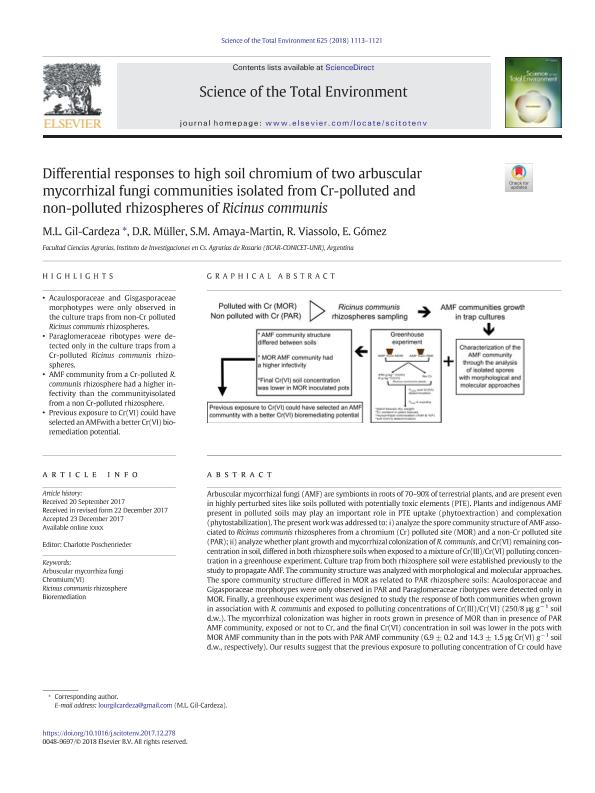Artículo
Differential responses to high soil chromium of two arbuscular mycorrhizal fungi communities isolated from Cr-polluted and non-polluted rhizospheres of Ricinus communis
Gil Cardeza, Maria Lourdes ; Müller, D. R.; Amaya Martin, Shirley Margarita; Viassolo, Rodrigo; Gomez, Elena del Valle
; Müller, D. R.; Amaya Martin, Shirley Margarita; Viassolo, Rodrigo; Gomez, Elena del Valle
 ; Müller, D. R.; Amaya Martin, Shirley Margarita; Viassolo, Rodrigo; Gomez, Elena del Valle
; Müller, D. R.; Amaya Martin, Shirley Margarita; Viassolo, Rodrigo; Gomez, Elena del Valle
Fecha de publicación:
06/2018
Editorial:
Elsevier
Revista:
Science of the Total Environment
ISSN:
0048-9697
Idioma:
Inglés
Tipo de recurso:
Artículo publicado
Clasificación temática:
Resumen
Arbuscular mycorrhizal fungi (AMF) are symbionts in roots of 70–90% of terrestrial plants, and are present even in highly perturbed sites like soils polluted with potentially toxic elements (PTE). Plants and indigenous AMF present in polluted soils may play an important role in PTE uptake (phytoextraction) and complexation (phytostabilization). The present work was addressed to: i) analyze the spore community structure of AMF associated to Ricinus communis rhizospheres from a chromium (Cr) polluted site (MOR) and a non-Cr polluted site (PAR); ii) analyze whether plant growth and mycorrhizal colonization of R. communis, and Cr(VI) remaining concentration in soil, differed in both rhizosphere soils when exposed to a mixture of Cr(III)/Cr(VI) polluting concentration in a greenhouse experiment. Culture trap from both rhizosphere soil were established previously to the study to propagate AMF. The community structure was analyzed with morphological and molecular approaches. The spore community structure differed in MOR as related to PAR rhizosphere soils: Acaulosporaceae and Gigasporaceae morphotypes were only observed in PAR and Paraglomeraceae ribotypes were detected only in MOR. Finally, a greenhouse experiment was designed to study the response of both communities when grown in association with R. communis and exposed to polluting concentrations of Cr(III)/Cr(VI) (250/8 μg g− 1 soil d.w.). The mycorrhizal colonization was higher in roots grown in presence of MOR than in presence of PAR AMF community, exposed or not to Cr, and the final Cr(VI) concentration in soil was lower in the pots with MOR AMF community than in the pots with PAR AMF community (6.9 ± 0.2 and 14.3 ± 1.5 μg Cr(VI) g− 1 soil d.w., respectively). Our results suggest that the previous exposure to polluting concentration of Cr could have selected AMF species with a higher infectivity and thus more likely to better contribute to reduce the pollutant concentration in the soil.
Archivos asociados
Licencia
Identificadores
Colecciones
Articulos(CCT - ROSARIO)
Articulos de CTRO.CIENTIFICO TECNOL.CONICET - ROSARIO
Articulos de CTRO.CIENTIFICO TECNOL.CONICET - ROSARIO
Articulos(IICAR)
Articulos de INST. DE INVESTIGACIONES EN CIENCIAS AGRARIAS DE ROSARIO
Articulos de INST. DE INVESTIGACIONES EN CIENCIAS AGRARIAS DE ROSARIO
Citación
Gil Cardeza, Maria Lourdes; Müller, D. R.; Amaya Martin, Shirley Margarita; Viassolo, Rodrigo; Gomez, Elena del Valle; Differential responses to high soil chromium of two arbuscular mycorrhizal fungi communities isolated from Cr-polluted and non-polluted rhizospheres of Ricinus communis; Elsevier; Science of the Total Environment; 625; 6-2018; 1113-1121
Compartir
Altmétricas



